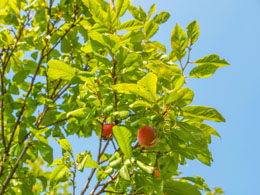How about growing some plum trees in your backyard? This is not as difficult as it sounds, and can be done with a little planning and a basic know-how about the proper methods.

Who doesn't like to see a plum tree covered with blossoms during the spring. You may grow this tree in your garden or backyard, where you can enjoy the blooms at leisure. Apart from being a visual treat, the tree also offers some juicy, fleshy and delicious plum fruits as well. Plum fruits are used for canning, to make jams and jellies, and also as a dessert. Growing plum trees is not a fussy task, and with a little care, you can enjoy the benefits.
Choosing the Right Tree
As in case of any other plant or tree, you have to be very careful regarding the selection of a plum tree to be planted in your garden. Choose the right tree as per your needs. If there is a space restriction, go for the dwarf fruit tree variety or free-standing fruit trees, which can grow up to 2.5 meters. There are also fan-trained trees, which grow to a height of 2 meters and a width of 3 meters, but they are not suitable for very small gardens. For larger gardens, bush-trained plum trees are perfect. These trees are free-standing, and grow to a height of about 4 meters. If you want large trees, go for half standard trees that can grow up to 6 meters; or standard plum trees, which can have a maximum height of 8 meters. Make sure that you choose a new variety with disease-resistant features. It is always better to buy different varieties to ensure pollination. You may use bare-rooted trees or potted ones.
Planting
The preferable time for planting plum trees is between late autumn to early spring. October is considered the best for this purpose. These trees like full sun. So make it a point to plant them in a place, where they get good sunlight. The soil must be well-drained and fertile; and it should not get soggy or extremely dry. Retain the moisture level through proper watering. Plum trees should not be planted near trees that absorb moisture from the surrounding areas.
The site should be prepared a month before planting. If the site was fertilized earlier for other crops, there is no need to add more fertilizers. Otherwise, add at least three handfuls of bone meal (for each tree) or any other fertilizer of your choice. No fertilizers should be added during the time of planting. You have to dig holes, preferably two feet deep and four feet wide. Each hole must be big enough to contain the roots of the trees. After planting the tree, it should be supported with stakes for a period of at least two years. The stakes should be tied to the main stem of the tree, using plastic ties.
How to Grow Plum Trees- The most important aspect of growing plum trees is pruning. If done correctly, pruning leads to proper growth of the tree and encourages fruiting. The right time for pruning a plum tree is fall, after harvesting the fruits. You have to remove the dead and damaged stems. Branches that are located closely may block sunlight. So, remove some of them, so that the remaining ones get enough sunlight.
- Nutrition is very important for plum trees to produce fruits. You can either use a root feeder, which is directly absorbed by the roots; or a fruit tree fertilizer, which can be dissolved in water and sprayed on the soil around the tree. Feeding has to be done during the onset of blooming, fruiting, and once when the fruits reach half their full size.
- Plum trees require regular watering, preferably every week or once in ten days. Use a slow-running hose or a root feeder sans fertilizer for watering. In case of insufficient water, the leaves may curl up or turn brown.
- Pests, especially insects, can affect the growth of plum trees. You can apply a dormant oil spray during winters or early spring. Use food safe pesticides during the fruiting season.
This is only a brief overview about growing plum trees in your backyard or garden. It is always better to gain a thorough understanding about the right methods beforehand. You may consult a horticulturist or the local nursery for this purpose.






 Who doesn't like to see a plum tree covered with blossoms during the spring. You may grow this tree in your garden or backyard, where you can enjoy the blooms at leisure. Apart from being a visual treat, the tree also offers some juicy, fleshy and delicious plum fruits as well. Plum fruits are used for canning, to make jams and jellies, and also as a dessert. Growing plum trees is not a fussy task, and with a little care, you can enjoy the benefits.
Who doesn't like to see a plum tree covered with blossoms during the spring. You may grow this tree in your garden or backyard, where you can enjoy the blooms at leisure. Apart from being a visual treat, the tree also offers some juicy, fleshy and delicious plum fruits as well. Plum fruits are used for canning, to make jams and jellies, and also as a dessert. Growing plum trees is not a fussy task, and with a little care, you can enjoy the benefits.